






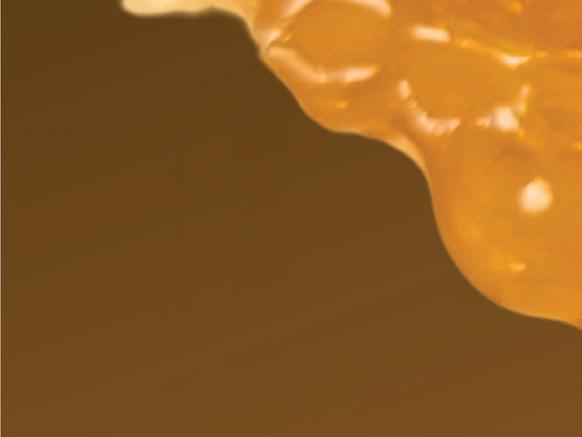







































SPRING 2 edible ® San Fernando Valley EAT. DRINK.
Celebrating Local Food & Drink in San Fernando Valley, Santa Clarita Valley and Pasadena MEMBER OF EDIBLE COMMUNITIES The Honey Issue ISSUE 7 • SPRING 2024
THINK. LOCAL




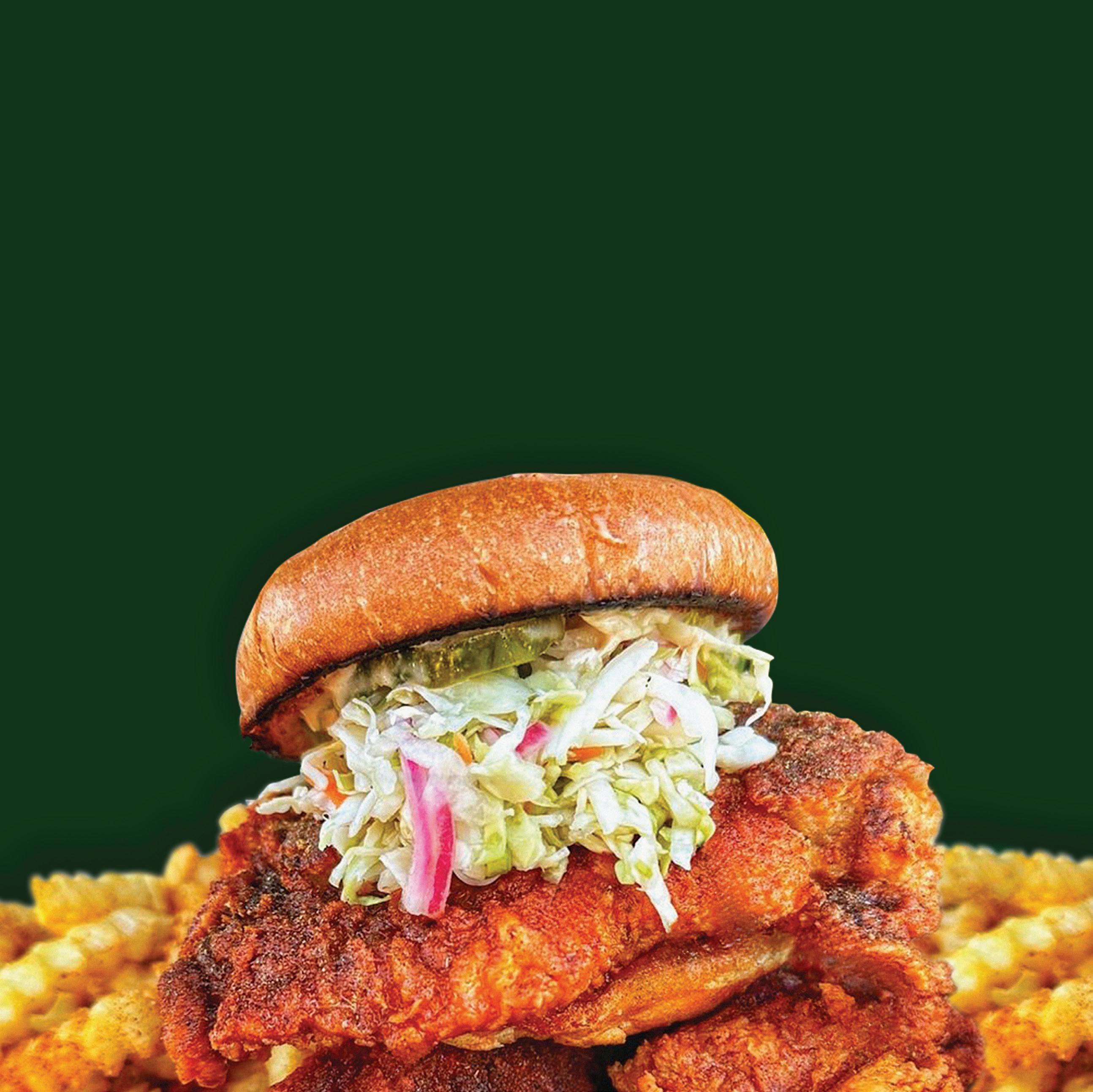

SPRING 2024 1 EdibleSanFernandoValley.com FRIED CHICKEN? DEFINITELY. *Limit One Per Person. Code Expires 6/30/2024 A MODERN FOOD HALL JAY BIRD’S • BURRATA HOUSE • HEY HEY • POKE ME SHRIMP DADDY • TAIL O’ THE PUP • CILANTRO LIME • & MORE WESTFIELD TOPANGA • 6600 Topanga Canyon Boulevard • Canoga Park CA 91303 EATPLAYTOPANGASOCIAL.COM $5 OFF YOUR ORDER *

Cover
Honey is a most super of superfoods, containing 31 minerals, trace amounts of many vitamins and plenty of antioxidants. It is also the only known food that can be safely eaten after thousands of years in storage. While honey bees aren’t the only insects that makes honey, most that we consume comes from domesticated bees. For more on beekeeping and honey, start on page 12.
SPRING 2024 Regulars 4 EDIBLE Epistles 12 The SEASONAL Table Recipes from the Hive 31 EDIBLE for Kids 34 OUR SPRING Table 38 Farmers’ Markets Guide Features 6 EDIBLE Notables 6 Newhall’s Sidecar Speakeasy BY SARENE WALLACE 8 Modern Day Dr. Dolittle BY AJA GOARE 10 Monsieur Crêpe BY VICTORIA THOMAS 36 Gracefully Fed BY CHELSEE LOWE 16 EDIBLE Wellness Herbal Electurary BY MARGUERITE NESTERUK 18 EDIBLE Endeavor Honey of a Hobby BY DAVID BOCK 24 CHEF Spotlight A Full Plate BY BRENDA REES 26 EDIBLE Exploration Going Dutch BY TAMI CHU 32 FIRST Person Lessons from a Smorgasbord BY CHRISTINA BERKE 40 LAST Bite Spring Veggie Frittata BY SAMANTHA SIROTA Recipes 12 Honey Cake 14 The San Fernando Brown Derby 15 Marigolds at Magnolia 37 Avgolemono Soup 40 Spring Veggie Frittata
CONTENTS


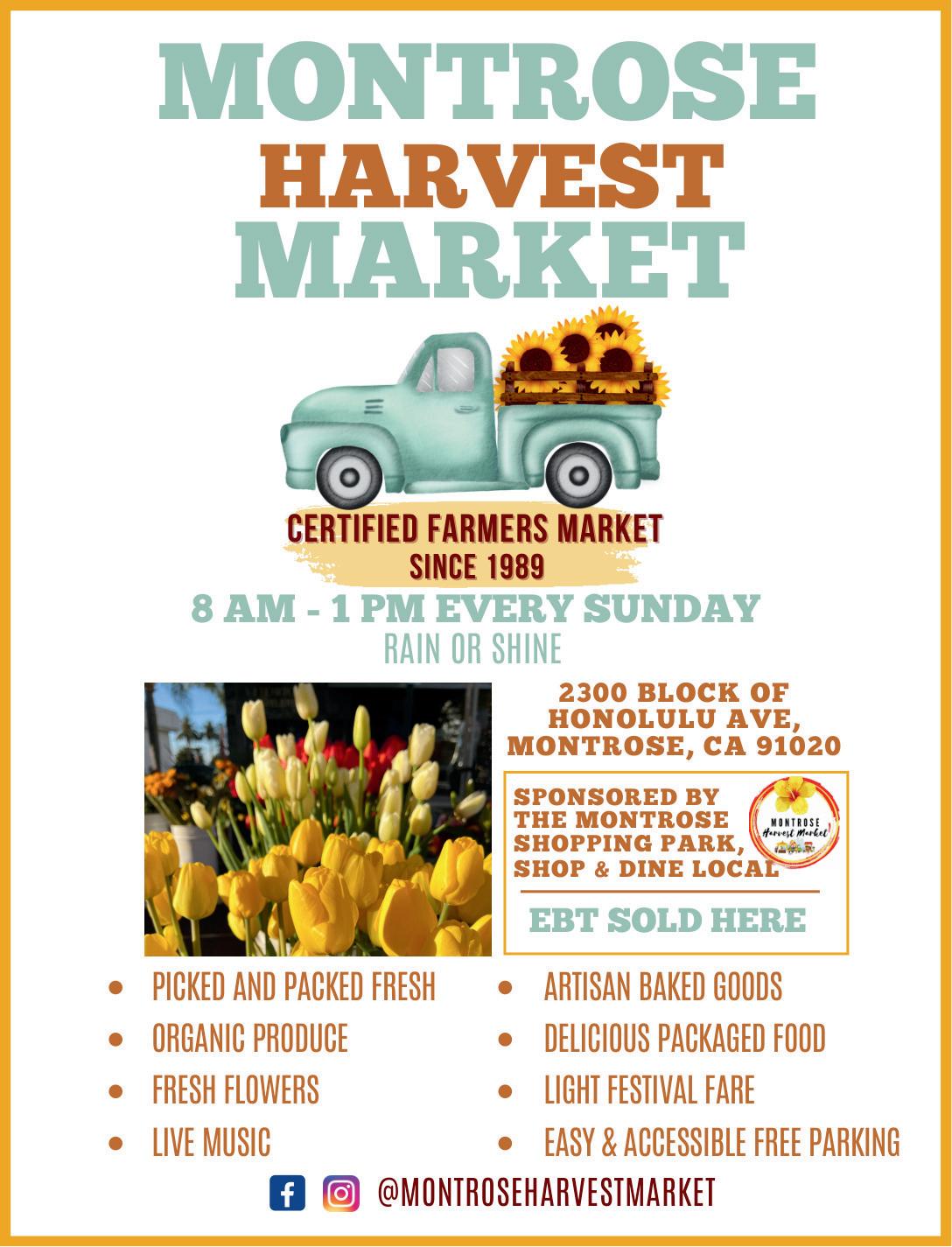

SPRING 2024 3 EdibleSanFernandoValley.com
EDIBLE Epistles
If you’d asked me about bees when I was a kid, I would have given you a much different answer than I would today. Probably something like, “Eek! Get them away from me!” Now I’d say, “Not all superheroes wear capes—honeybees have wings.”

It took me a long time to fall in love with bees and to appreciate them for their essential role in our food system. These days, bees need our support to keep being our heroes as pollinators and in helping to maintain the health of our ecosystem. And delivering delicious honey, perfect for making cocktails (see page 14) or Honey Cake (page 12).
So if you can, avoid using insecticides or other pesticides in your yard because they can kill bees. Bees can be killed immediately if they come in contact with an insecticide while foraging. Or if a tainted bee flies back to its colony, it can bring contaminated pollen or nectar or residue on its body, according to the University of Georgia Bee Program’s website.
When we help honeybees, they gift us with honey. There are over 300(!) different types of honey in the United States, per the National Honey Board. If you’ve shopped for honey at a local farmers’ market, you’ve likely seen a range of colors—from almost white to molasses-dark—and tasted each honey’s distinct flavors, depending on where the bees foraged. (For more on this, see page 22)
I’m partial to the floral notes of orange blossom honey. But you might prefer avocado honey, with its dark color and pronounced flavor with buttery tones. Or even mild sage honey that takes a long time to get grainy.
Whichever honey—or multiple varieties—you choose, remember the bees that made it for you. Join us in celebrating World Bee Day on May 20.
 Sarene Wallace Managing Editor
Sarene Wallace Managing Editor






Sarene Wallace
Cheryl Angelina Koehler
David Bock
Christina Berke Ramiah Chu
Aja Goare
Stephanie Helguera
Chelsee Lowe
Marguerite Nesteruk
Brenda Rees
Samantha Sirota
Victoria Thomas
Sarene Wallace





OUR MISSION: Currently in its second year, was founded to document and bring to life the interest in farm-to-table, organic and natural foods, and to acknowledge the people and communities who feed and sustain us. We want to inspire readers to support and celebrate the growers, producers, chefs, food and beverage artisans and other food professionals in our community.

4 SPRING 2024 Edible San Fernando Valley edible® San Fernando Valley publisher, editor in chief
editor
copy editor
Tami Chu managing
Doug Adrianson design
contributors
sales
subscriptions
contact us Edible San Fernando Valley 2470 Stearns St. #142 Simi Valley, CA 93063 805-622-9355 info@ediblesfvalley.com Edible San Fernando Valley is published seasonally, four times a year. We are an advertising- and subscriber-supported publication, locally and independently owned and operated and a member of Edible Communities, Inc. Distribution is throughout the San Fernando Valley, Santa Clarita Valley and Pasadena and by subscription for $29 per year. Every effort is made to avoid errors, misspellings and omissions. If, however, an error comes to your attention, please accept our sincere apologies and let us know. No part of this publication may be used without written permission of the publisher. © 2024. All rights reserved.
Mary DiCesare mary@edibleventuracounty.com
EdibleSanFernandoValley.com info@ediblesfvalley.com
edible® edible San Fernando Valley San Fernando Valley CelebratingLocalFood&Drink,SeasonbySeason Issue4 Summer2023 MemberofEdibleCommunities edible ® edible San Fernando Valley SustainableLivingMadeEasy Farmers’MarketTips Seasonal Walnuts SanFernandoValley CELEBRATINGLOCALFOOD&DRINK,SEASONBYSEASON ISSUE2 WINTER2023 WINTER 2023 MEMBEROFEDIBLECOMMUNITIES










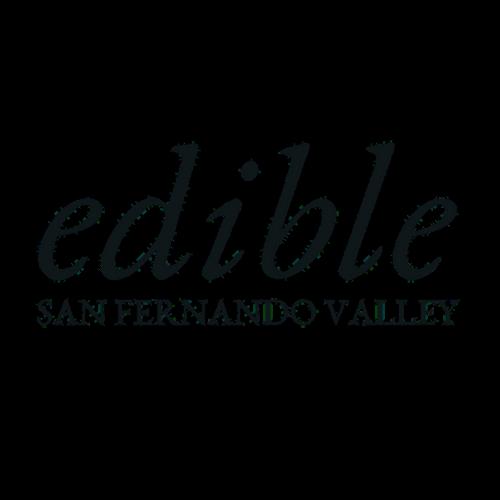




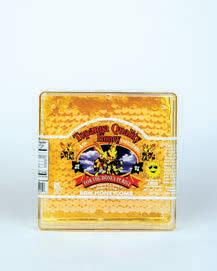













SPRING 2024 5 EdibleSanFernandoValley.com Whether from our kilns, our kitchen, or our organic garden, we specialize in producing small batch artisanal hot sauces and handmade ceramic kitchen food prep items. creativefirekilnandkitchen.com Order today! All Good Things Come From Earth, Fire, and Water BENNETT’S HONEY FARM Tasting ROOM USE CODE ESFVSPRING24 TO GET YOUR DISCOUNT Expires June 30, 2024 *See disclaimer on the checkout page of our website at bennetthoney.com. 20% OFF ALL HONEY PRODUCTS 3176 Honey Lane Fillmore, CA 93015 Mon-Fri 8 am - 4:30 pm Sat & Sun 9 am - 5 pm ww w.bennetthoney.com 805.521.1375 Great Holiday Bennett’s holiday •Lotions • Candles • Books • Gourmet & BBQ Sauces • Honeycomb and MUCH More! TO GET YOUR 20% DISCOUNT ************************ BRING THIS COUPON INTO OUR STORE OR USE THIS QR CODE TO ORDER ON OUR WEBSITE: BENETTHONEY.COM ************************ Topanga Quality Honey 3176 Honey Lane · Fillmore, CA 93015 · bennetthoney.com · 805.521.1375 Mon - Fri 8am - 4:30pm · Sat & Sun 9am - 5pm Treat yourself to a year of Edible San Fernando Valley delivered to your door . Subscribe online at EdibleSFValley . com

SHHHH!
Newhall’s Sidecar Market speakeasy rewards those who know to enter
WORDS BY SARENE WALLACE
Psst. I have a secret for you—don’t tell anyone.
The Sidecar Market on Main Street in Newhall is easy to miss by day but has a classy, if-you-know-youknow vibe by night. The speakeasy has no outdoor signage and Google leads you to an upstairs ReMax Realty office. (A pleasant woman behind the desk will assure you that it is a real estate office and not a speakeasy.)
Opened September 2023, the Sidecar is the brainchild of the team behind the Old Town Junction Restaurant, which serves elevated American fare adjacent to the speakeasy. The origin story of the cocktail-forward spot goes like this: When a record store vacated the space, Shane Bothwell (general manager of Sidecar Market and The Old Town Junction restaurant) and Executive Chef/Owner Daniel Otto started “spitballing ideas” during COVID on its replacement. Otto brought up a speakeasy and it seemed like a fun idea, says Bothwell.
“It took us a little over a year to create the space,” says Bothwell. “There’s nothing like it out here [in Santa Clarita Valley].”
Interior decorator Shawlyn Otto (Chef Otto’s wife) draped the space in rich emerald green and gold tones. Mood lighting and dark floors and furniture complement the palette. Framed historical pictures of the location and family members who had a hand in the business decorate the walls. “The chef calls it a ‘Love Wall,’” says Bothwell.
But outside at night, you don’t see any of this. All you see is a small, well-lit retail space with a large, lighted Sidecar Market sign mounted on a wall.
EDIBLE Notable 6 SPRING 2024 Edible San Fernando Valley
A hostess knocks on a wood-paneled wall and a door magically opens into the speakeasy...

Following the speakeasy theme, the front door is locked. A hostess invites me into the small space outfitted with colorful artwork and a display case with custom, one-of-a-kind ornately decorated knives.
All the items are for sale, though there’s more to this story.
Another hostess knocks on a wood-paneled wall and a door magically opens into the speakeasy, an intimate space that holds only 34 people.
I perch at the bar while Frank Sinatra croons about the moon. I look around and think Frank would be at home here, his hand wrapped around a classic Martini.
The Sidecar has an expansive, upscale alcohol menu of single spirits, beer, wine and wow-worthy cocktails. The Signature, the house Old Fashioned, uses Otto Bothwell High West Bourbon (a collab with the Park City, Utah, distillery) and smoked with cherry wood. The Last Word is spiked with Ojo de Tigre Mezcal, green Chartreuse, Luxardo liqueur and fresh lime. A smoke-filled bubble is the impressive drink topper. And there’s always a Dealer’s Choice (ask the bartender).
“Our culinary team and mixologists are always crafting daily and weekly specials to keep it fun and exciting,” Bothwell tells me.
The scratch kitchen’s food menu uses local and sustainable resources, says Otto.
“The inspiration [for the menu] was what felt good and what I personally liked to eat,” he adds. “The great option with a menu like this is it will keep progressively changing throughout the months. Which gives me culinary freedom and creativity for a fun, balanced, seasonal menu.”
Scanning the menu, diners might find items like an A5 Japanese Kagoshima tenderloin steak and Hokkaido smoked diver scallops, along with caviar and toast and “Sugar Daddy” grilled cheese.
You’ll need to make reservations online because there’s no phone. Walk-ins can grab a seat at the green marble bar, though.
Now you’re in on the secret.
SPRING 2024 7 EdibleSanFernandoValley.com
Market
Main St., Newhall SidecarMarket.com
Sidecar
24273
EDIBLE Notable
MODERN DAY DR. DOOLITTLE
At The Gentle Barn in Santa Clarita, visitors can talk to the animals
WORDS BY AJA GOARE

As Ellie Laks left a Los Angeles petting zoo in 1999, she was moved by the pleading look of an ailing goat. “I asked the owner if I could have her,” says Laks. “They said, ‘no.’ So I asked if I could buy her. They said ‘no.’”
Laks came back every day for the next 12 days, paying admission so she could spend the day with her furry friend. Before leaving each day, she’d ask, “Can I take this goat?” Annoyed by the young woman’s persistence, the owner eventually relented.
This marked the start of her life’s mission, a dream she’d fostered since childhood: to provide a sanctuary for wounded and abused animals.
Once she brought Mary home, the goat was healthy in just four weeks. “She was bouncing around like a goat is supposed to,” Laks remembers. High on the success of this rescue, Laks returned to the petting zoo and ended up taking every crippled or elderly animal that had been relegated to the back lot.
In the half-acre backyard of her Tarzana home, Laks tended to two dozen animals. She knew her work wasn’t done and that if she was to continue, she’d need more land.
Laks founded the nonprofit The Gentle Barn Foundation and moved it to a six-acre property in Santa Clarita in 2003. The property is open to visitors on Sundays and features large horse and cow pastures, a red and white barnyard for smaller animals, an organic vegetable garden, shade trees and a panoramic view of the mountains.



Where some people see ingredients for dinner, Laks and her staff— including a volunteer whom she later married—view the animals as friends. “My cows are as smart as my dog; they just moo instead of bark,” Ellie Laks says.
Along with room to roam, the animals enjoy massages, supplements and even acupuncture. It’s a stunning turn of destiny for these creatures, most of which were headed for slaughter before Laks intervened.
John Lewis Thunderheart, a cow born in 2020 on a slaughterhouse floor, is one of The Gentle Barn’s residents. Laks doesn’t like to use terms like steer or bull because the meat and dairy industry uses those to attribute an economic value to them. “To us they are family, and we call them all cows,” she explains.
“We have relationships with some of the slaughterhouses in L.A.,” says Laks. “I spoke with the owner and he wouldn’t give me the mother, but he offered the calf.” She brought the calf home. She treated his pneumonia and fever with medication and a nebulizer and bottle-fed him. “He lived in my home for nine months,” says Laks. “I slept with him and even ate hay so he could learn by watching me.”
On one of their daily walks through the cow barn on the property, what Laks calls a “play date,” John Lewis Thunderheart had such a great time that he declined to return home with Laks. He wanted to be with his own kind. “That was his choice,” she says, adding that John Lewis still lives with them on the property and will for the rest of his life.
If Laks sounds like she’s reminiscing about a son, it’s because her love for these animals runs deep. Where some people see ingredients for dinner, Laks and her staff—including a volunteer whom she later married—view the animals as friends. “My cows are as smart as my dog; they just moo instead of bark,” Laks says.
As a vegan, Laks is careful not to impose her beliefs on visitors. “A vast majority of our visitors are meat eaters,” Laks says. “We invite them to hug the cows, rub the tummies of our pigs, pet the chickens and cuddle the turkeys. Once people have a chance to really connect with these animals, they can decide for themselves.”
People can find comfort from “cow hug therapy,” a therapeutic experience for those suffering from grief, loneliness or depression. Guests are invited to build confidence and learn body language through “equine therapy,” experience joy and connection with “barnyard therapy” or develop reading skills through the barn’s literacy program.
It’s a moo-ving experience, you might say.
To sponsor the animals or donate to The Gentle Barn, visit GentleBarn.org.
Aja Goare is a local food writer and editor who works with multiple Edible magazines. She and her husband, Dustin, love to travel across the Valley looking for great eats. She’s also a child advocate, outdoor explorer and artist.
SPRING 2024 9 EdibleSanFernandoValley.com
Photos courtesy of The Gentle Barn
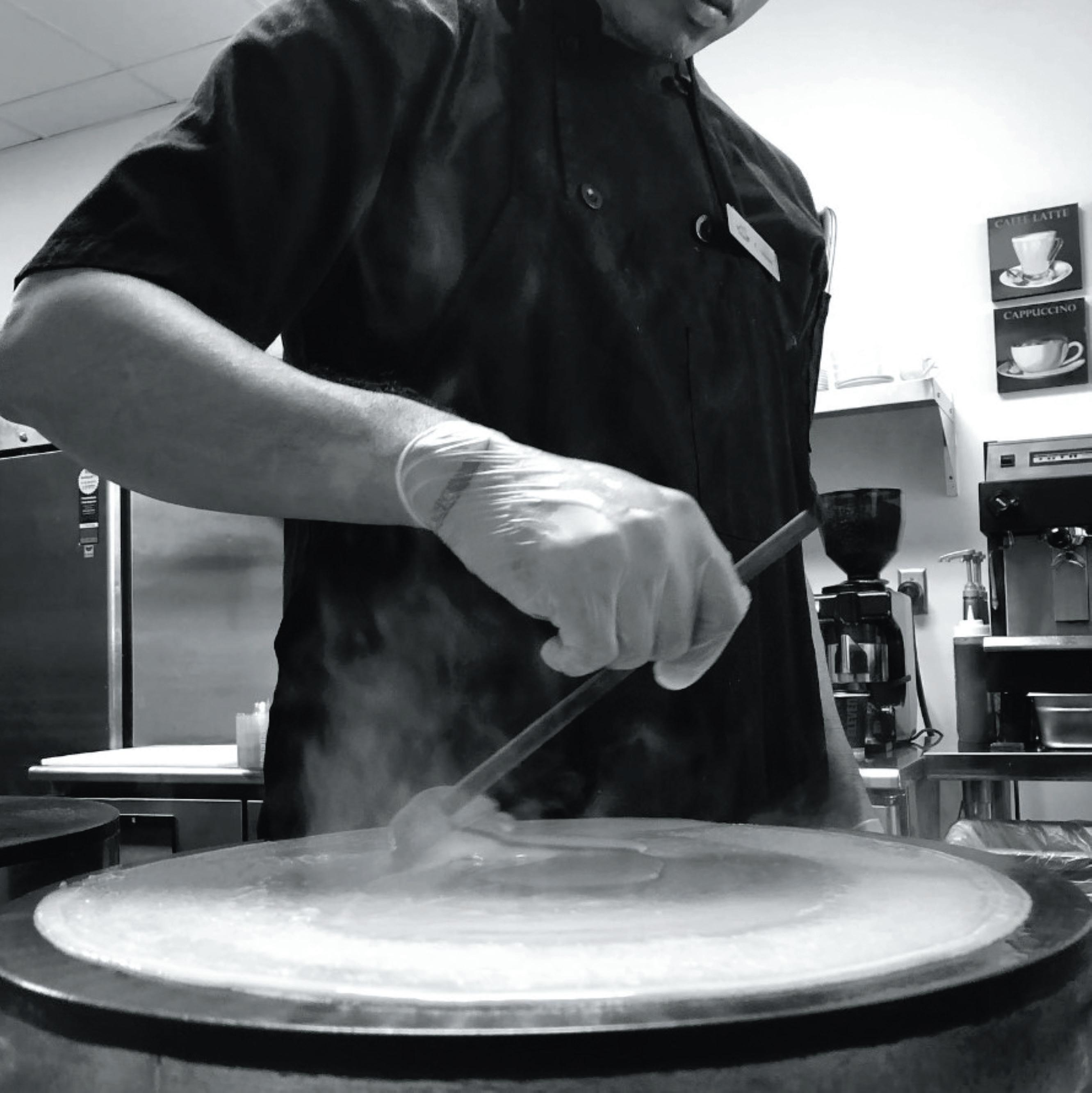
BON APPÉTIT
Petite Sierra Madre café delights with big flavors
WORDS BY VICTORIA THOMAS
10 SPRING 2024 Edible San Fernando Valley EDIBLE Notable
Photo courtesy of Monsieur Crepe
With a jaunty bistro vibe, Monsieur Crêpe Café, a self-described “hole in the wall” in Sierra Madre, serves a concise menu of Cali-French dishes and deconstructed classics updated to delight a modern Southern California sensibility.
Owner Xavier Sosa and Chef Guilbert Balmaceda have been a team since Sosa bought the restaurant in December 2022, just in time to celebrate the crêperie’s 10th anniversary in October 2023. Balmaceda started working for then-owner Aurélien (Tony) at the café in 2015 and stayed on to lead Sosa’s new venture.
In March 2024, they initiated a kitchen remodeling project with a new stove and oven to serve more menu items and expand the breakfast and dinner options. “We also wanted to offer more quiche quantities because we run out really quick, as they are made fresh daily,” says Sosa. (Of course, you can also enjoy sweet and savory crêpes.)

Dinner is offered Thursday through Saturday with a menu that includes poissonniere (subtitled “linguini with marinara”), ratatouille served with polenta made smoother and lighter with an infusion of Greek yogurt, and beef bourguignon made with pancetta in place of bacon for a less smoky taste.
Balmaceda is not troubled by the robust cross-pollination between the heartiest expressions of French and Italian cuisines. “We listen to the feedback from our guests, so sometimes we depart from tradition,” he says. “Food is not a museum, stuck someplace in the past. It’s an alive thing that responds to time and place, based on what’s available.”
In this sense, Monsieur Crêpe Café is more faithful than most to the essence of French cooking, especially regarding food encountered outside the city limits of La Ville Lumière (the City of Light). Consider the bouillabaisse, which the chef calls “peasant food.” Monsieur Crêpe’s deluxe version is loaded with choice mollusks and crustaceans (Venus clams, manila clams, mussels and crab claws). This briny bounty takes the dish far afield from its humble origins among the fisherfolk of Marseille who used bony rockfish they couldn’t sell at market as the stew’s base.
And yet Balmaceda’s interpretation reflects the improvisational attitude of the original. Whatever seafood is freshest goes into the pot. The chef, who lives in Torrance, routinely makes the drive to a San Pedro
fishmonger he’s worked with for more than a decade to procure the highly perishable ingredients that may vary slightly from week to week.
The small size of the 750-square-foot eatery poses storage and space challenges. The chef explains, “Refrigeration is always a huge issue with seafood, and we don’t have tremendous space for cold storage. So this means we have to buy ingredients more frequently. It also means that the selection may be different tomorrow. Sometimes we wing it, and if we run out, we run out!”
Balmaceda then musters a convincing Gallic shrug, though he’s from the Philippines.
The chef maintains the attitude and style of Monsieur Crêpe Café with an array of sophisticated choices in the kitchen. Among them: saffron and fennel. “Not all saffron is created equal,” he says. “Just spend the money. Buy the good stuff. You need so little of it, and it’s totally worth it.”
As for fennel, he calls it “terribly underrated,” and explains that it’s the magic in his velvety lobster bisque that he deglazes with vermouth, port and brandy. Pernod is also a favorite for its licorice-anise flavor, subtly finding its way into the bouillabaisse and le escargot. And then there’s this sage advice: “Never cook with wine you wouldn’t drink.”
The kitchen is visible from each of the café tables and from the street, drawing the curious and the hungry. Aromas of melting butter and sizzling shallots drift out under the trembling purple bower of faux wisteria that Sosa incorporated into the decor to honor the annual Sierra Madre Wistaria Festival.
Regulars passing the doorway call out to the chef, who knows them all by name. He visits every table while diners dig in, explaining “We wouldn’t be here without them.”
One last thing: If you’re using GPS, type in “Monsieur Crêpe Café” instead of the address, which wants to take you to Arcadia.
Victoria Thomas is a Southern California culture journalist with a passion for adventurous, artisanal ethnic food. Her writing explores art forms in all media, especially those she can eat.
Monsieur Crêpe Café
54 W. Sierra Madre Blvd., Sierra Madre
MonsieurCrepe.com
SPRING 2024 11 EdibleSanFernandoValley.com
Photo by Victoria Thomas
FROM the Hive
HONEY CAKE
Winner of the honey recipe contest at The Valley Hive
BY ANNA BOSINYAN

Crumb-coated and layered with butter cream, this honey cake truly melts in your mouth. This recipe is passed down from my aunt back in Armenia, who is a great cook and has always inspired me to bake. Any time I make this cake, it brings back fond memories of our time together. Although this cake is a traditional baked good in Armenia, I added my own alterations based on family feedback and it became a first prize winner at a honey dessert contest at The Valley Hive in Chatsworth. I prefer to use ValleyB’s Honey, which comes from my father’s beehive, since it is pure and natural. I am a full-time mother and employee who finds joy and comfort in baking and cooking. Any time I bake, I put in hard work and effort to ensure my family enjoys healthy yet delicious crafted foods.

Makes 1 large cake
For the dough
1 cup sugar
1 cup honey
1 teaspoon plus 1½ teaspoons baking powder
100 grams butter (or about ½ cup)
4 eggs
100 milliliters vegetable oil (about 6¾ tablespoons)
100 milliliters water
1½ cups all-purpose flour, plus 4–5 tablespoons more
For the buttercream filling
4 tablespoons cornstarch
1 cup sugar
2 cups cold milk
150 grams butter, softened
2 teaspoons vanilla extract
To make the dough: Whisk together sugar, honey and 1 teaspoon of baking powder. Add to a medium saucepan and simmer on a low heat until the mixture caramelizes (changes color to red/brown), stirring regularly.
Add butter and stir until it completely melts. Remove from heat and let it cool for about 5 minutes.

In a separate bowl, whisk eggs, vegetable oil and water until mixed.
Add to the honey mixture and whisk gently until incorporated. Put the saucepan back on medium-low heat and stir in 1½ teaspoons of baking powder. Simmer. When it starts bubbling on the surface, stir, cooking, for 1 minute more, then remove from heat and pour into a separate bowl.
Immediately add 1½ cups of flour to the mixture and stir to incorporate.
While the dough is still hot it will stick to your hands; sprinkle dough with additional flour to collect it together, then divide into 4 parts. It may feel runny, but will tighten as it cools down.
Preheat oven to 350°.
Form sectioned dough into 4 balls. Between two sheets of parchment paper, roll out each ball into desired shape (I use a rectangle but a circle can work too). Dough should be rolled until about ¼ inch thick, similar to pie crust. Remove one of the parchment sheets and then bake each flattened section on a jelly roll pan or cookie sheet for about 10 minutes, or until edges begin to color.
Remove from the oven and cook the next sheet. Continue until all 4 sections are cooked and cooling.
To make the buttercream: Mix cornstarch and sugar, add milk and stir well. Cook in a
medium saucepan over mediumlow heat until mixture is thick, stirring continuously.
Remove from heat and allow to cool.
In a stand mixer or large bowl with a hand mixer, add softened butter and mix on medium high for about 10 minutes. Add the cooled milk mixture little by little to the butter, mixing well between each addition. After it is all incorporated, add vanilla. Filling should have a fluffy texture. Divide into 4 parts.
To assemble: Stack the cooled cake layers 1 at a time, applying cream on every layer. Finish with desired topping.
Editor’s Note: The photo has a blood orange honey syrup drizzle, made with equal parts blood orange juice and honey and stirred until fully combined. Other options for a drizzle or topping could be lemon blueberry, chocolate, strawberry or any creative idea you might have!
12 SPRING 2024 Edible San Fernando Valley

Show Me the Honey

Level up your cocktails with a spot of local honey. It’ll add a more complex and nuanced flavor than, say, a sugar-based simple syrup and be more interesting. Honey also brings in notes of the honey varietal. These cocktail-party-worthy drinks showcase how honey works equally well with bourbon or vodka. (Or tequila or gin, for that matter.)
When deciding which honey to use, bartenders say clover and alfalfa are all-purpose options. Orange blossom honey works well with citrusy drinks, making it a tasty choice for The San Fernando Brown Derby. For Marigolds at Magnolia, try a wildflower honey to match the floral marigolds.
To incorporate honey into a cocktail, you can make a honey syrup as directed for the Marigolds at Magnolia. Or slowly stir the honey into the drink ingredients with a bar spoon (a long-handled spoon) until the honey is dissolved. Whatever you do, don’t add honey to a cocktail shaker with ice— you’ll end up with a hard-gloppy mass that’ll refuse to incorporate into the drink.
The San Fernando Brown Derby
Makes 1 cocktail
½ ounce honey
1 ounce fresh grapefruit juice
2 ounces bourbon
Grapefruit twist for garnish
Add honey and grapefruit juice to a cocktail shaker and stir until honey is dissolved.
Add bourbon and ice and shake. Strain into a chilled coupe glass and garnish with grapefruit twist.
Courtesy of The San Fernando in Glendale (TheSanFernando.com).
FROM the Hive
14 SPRING 2024 Edible San Fernando Valley

Marigolds at Magnolia
Courtesy of the Magnolia House in Pasadena (TheMagHouse.com).
Makes 1 cocktail
2 ounces vodka
1 ounce lemon juice
½ ounce chilled Marigold Syrup (recipe below)
¼ ounce chilled Honey Syrup (recipe below)
Marigold flower for garnish
Add all ingredients to a cocktail shaker. Give the shaker a medium shake.
Double-strain cocktail into a chilled coupe glass. Garnish with a marigold flower.
Marigold Syrup
1 liter water
5 cups sugar
1 box dried marigold flowers (approximately 50 flowers)
Combine water and sugar in a saucepan over medium heat. Stir. When sugar is dissolved, add marigold flowers, stir and simmer for 12 minutes. Remove from heat and let cool. Strain the syrup twice through cheesecloth. Refrigerate.
Honey Syrup
1 cup honey
⅓ cup hot water
Combine ingredients in a small bowl and stir thoroughly. Let cool before using. Refrigerate.

SPRING 2024 15
Just a Spoonful of Honey
Herbal electuaries are sweet medicine
WORDS AND PHOTO BY MARGUERITE NESTERUK
Bees are a keystone species. This means that other species are largely dependent on them and if bees were removed, the ecosystem would suffer greatly. Our diet would be incredibly and painfully boring if we didn’t have bees. Did you know that one out of every three bites of food we consume is thanks to bees? All pollinators enable us to have real food—fruits, vegetables and nuts—as well as other species across the world. Honey bees alone pollinate 80% of flowering plants.
This brings me to the alchemy of making and enjoying an herbal electuary, which is an herbal honey. Electuaries are said to date back to ancient Arab culture. During the Middle Ages, electuaries were used to treat people who were sick or who were trying to keep up their strength during a long illness.
Today, we still use herbs and honey for nourishment, health, healing and to enhance overall well-being. And they’re delicious. The best part, though, is that herbal electuaries are easy to make and simple to fit into your daily routine or diet.

Here are Marguerite Nesteruk’s favorite herbs to add to an electuary for their healing properties. These herbs offer many healing properties, but we only included their most prominent use. Nesteruk likes to source herbs from Wild Terra apothecary in Highland Park.
• Burdock root: Purify the blood
• Chamomile: Relaxation
• Cinnamon: Circulation
• Ginger: Digestion
• Lavender: Calming
• Lemon balm: Anxiety
• Nettle: Nourishment
• Rose: Heart health
• Thyme: Throat health
• Tulsi: Stress release
• Turmeric: Inflammation
Creating an Herbal Electuary
There are a lot of electuary recipes, but I have never followed any. I like to see what comes through the moment I sit down with the herbs and the honey. That said, here are a few guidelines to help you get started.
Use organic, raw, local or manuka honey, a honey from Australia or New Zealand that has antioxidant, antimicrobial and anti-proliferative capacities. As a base, honey is rich
EDIBLE Wellness
16 SPRING 2024 Edible San Fernando Valley

in nutrients, high in antioxidants, is antiviral and has anti-inflammatory, antibacterial and antimicrobial properties. Add organically grown powdered herbs to the mix and you have even more health benefits.
You can either purchase powdered herbs or use a coffee grinder or high-powered blender to grind your dried herbs into a powder. Put ½ cup of powdered herbs into a two-ounce jar and mix with ¾ cup of honey. You can vary the amount of honey or herbs to suit your taste and your preference for a thicker or thinner mixture.
Lick the spoon; it’s a must. (Well, not really but it’s a nice treat.) Then label the jar and store it in a cool, dark place or refrigerate it. It will keep six to 12 months, depending on the herbs used. I don’t refrigerate my electuary mixtures, but if you choose to and they crystallize, just put the jar in some warm water to melt the crystals. The health benefits of herbal electuaries vary based on the herbs you use to infuse the honey. See the list (opposite page) to learn about some of my favorite herbs to use in an electuary.
I love that this medicine is ready to enjoy immediately. Enjoy a spoonful alone or stir into hot tea or water. You can also spread some on toast, drizzle it over a bowl of oatmeal or add it to a smoothie. The options are almost endless.
As you enjoy your herbal electuary, remember to thank the bees and all the other amazing pollinators and plants for the delicious and medicinal ways they enhance our lives and this world.
Marguerite Nesteruk is the owner of Resonating Earth and an herbalist, Reiki master, earthenergy healer, tea blender aficionado and friend to bees. She also leads a variety of herbal tea ceremonies and tea experiences for corporate, public and private groups. Learn more at ResonatingEarth.org or @ResonatingEarth.

Honey, You’re the Real Deal
Not all honeys are created equal. To make sure you’re purchasing 100% real honey, follow these tips:
Buy Local: Purchase honey from a local beekeeper or farmers’ market vendor. Talk to them and you’ll learn a lot about the honey and where the bees foraged. (This honey likely will be more flavorful, too.)
Just One: Honey should be the only ingredient. Stay away from any honey that contains high-fructose corn syrup, maltose syrup, glucose or fructose.
Good Words: “Raw” and “unfiltered.” This honey will have more health benefits than processed honey.
Organic Truth: If honey is labeled “certified organic,” it was imported and certified by the country of origin. (The USDA cannot certify honey as organic.)
Not Ultra: Stay away from honey that’s “ultra-filtrated.” In this process, honey is heated and forced through tiny filters to catch the pollen.
Certified: True Source Honey is a nonprofit organization that grants honey the “True Source Certified” label. This means the honey can be traced from hive to home and has been tested for authenticity and third-party audited.
SPRING 2024 17
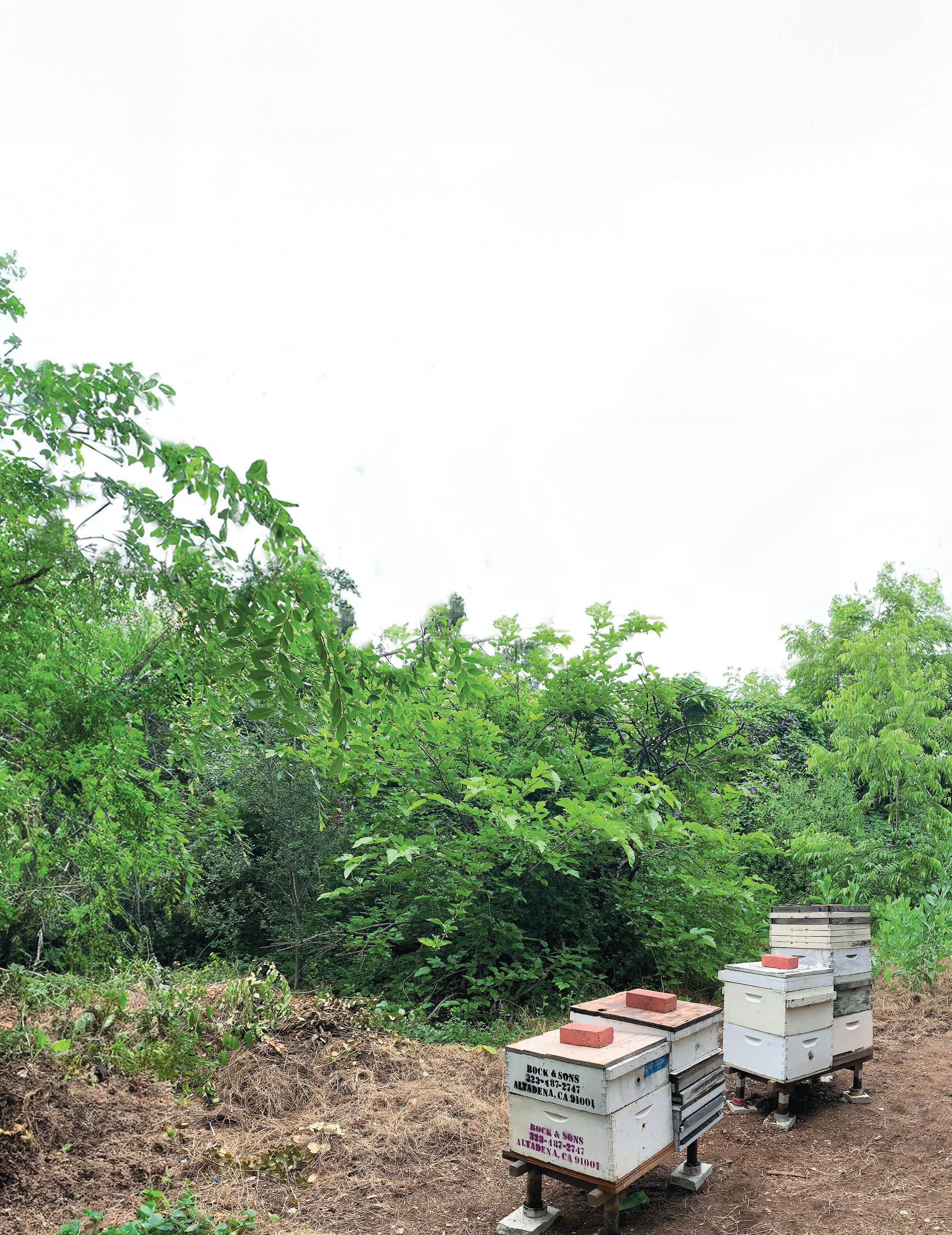
HONEY OF A HOBBY Urban beekeeping is bee-utiful
WORDS AND PHOTOS BY DAVID BOCK
One reason keeping bees is so fascinating is the inherent mystery: What’s happening inside the box? If you’re curious to learn the answer, and you’re not allergic to bee venom, you might be a future urban beekeeper.
A hive might be a treasure chest of succulent, aromatic honey and 50,000 healthy bees, or a Pandora’s
Box of stinging pandemonium. It all depends on the beekeeper’s skills. There are many ways to successfully manage beehives in a residential yard. It’s not easy to summarize a hobby that is equal parts animal husbandry, pest control and gourmet food production. What follows is a very abbreviated overview. (The real danger of beekeeping is not the stings; it’s becoming so obsessed with bees, their biology and behavior that you talk about nothing else, bugging your family and friends.)
FIRST THINGS FIRST
To get started, join a local beekeeping club. Founded in 1873, the Los Angeles County Beekeepers Association provides information and education for aspiring apiarists and commercial beekeepers. At
EDIBLE Endeavor
18 SPRING 2024 Edible San Fernando Valley

monthly meetings, in person and by Zoom, experienced members freely dispense advice, and guest speakers share specialized research. New members can (and should) take advantage of Beekeeping 101, a monthly handson class for first-year beekeepers. Membership is $20 a year.
Another great resource is the nonprofit group HoneyLove.org. Thanks to the efforts of HoneyLove, beekeeping became legal in the City of Los Angeles in 2015. The backyard beekeeping ordinance passed by the LA City Council is the basis of most beekeeping regulations in other LA–area communities. HoneyLove hosts a variety of monthly events for honeybee enthusiasts, even if you’re not (yet) a beekeeper.
SETTING UP YOUR HOME APIARY
Regulations vary by community. To ensure you comply with your local laws, call the Los Angeles County Department of Agricultural Commissioner at 626-575-5466 to find out if backyard hives are allowed at your address.
In general, the size of your yard determines the number of hives you can have. The formula is one hive for every 2,500 square feet of property.
Your hives must be located in your backyard and must be placed at least five feet from your property line.
A water source for the bees is essential! During the heat of summer, an active hive can drink a quart of water or more every day. Your water source can be as fancy as a fountain equipped with a circulation pump, or simply a five-gallon bucket and a few bunches of water cabbage.
Buzzed Honey’s beekeeper Conor stands proudly in their Altadena apiary





Top left: The author and his sons, Leo and Simon, admire a frame of fresh honey.
Top right: Buzzed Honey’s customer asked for a hive to be placed on this (stationary) train car, giving the bees something unique to build in.
Left: Buzzed Honey beekeepers are often asked to remove hives from places that are inconvenient or dangerous for homeowners. In this case, the swarm of bees had moved into a birdhouse. Our brave beekeepers opened it up (second) and carefully moved the bees into hive boxes so they could continue happily making honey.
Below: Beekeeper Simon prepares the smoker to calm the bees before inspecting the hives.

TOP TOOLS OF THE TRADE
Beekeeper’s Suit and Gloves: Inspect your hive without reliable PPE, and you won’t enjoy keeping bees. Colonies have widely different personalities, ranging from nearly tame to terrifyingly defensive. In our region, a ventilated suit is essential during summer.
Hive Tool: A prybar-knife combo, the hive tool is essential for moving frames, opening the hive, separating boxes, scraping wax comb and many other tasks.
Smoker: When their hive is opened, guard bees emit a pheromone (scent) that tells their sisters to sting the trespasser. Cool, dense smoke harmlessly interferes with the bees’ ability to get the message. The result? Calmer bees and happier beekeeper.
POT OF GOLD
Honey production can vary dramatically, depending on the weather, especially rainfall, your location and even the genetics of your bees. If everything goes right, a single hive may produce 40–60 pounds of extra honey to share with you.
No matter how much honey you harvest, your friends will want to try it. Their first question will be: Which flowers did the bees visit to make this magical elixir? Foraging honeybees fly up to four miles from their hive in search of flora, so urban honey generally contains a great number of nectar sources. It is this variety, I believe, that gives urban honey its incomparable flavor.
If you’re not a beekeeper—yet—and there’s a beekeeper in your neighborhood or at a local farmers’ market, buy their honey. You’ll be amazed by the depth of flavors that are missing from commercial supermarket honey.
In 2012, David Bock and his sons, Leo and Simon, started keeping bees in their backyard. Since then, operating as Buzzed Honeys, Inc., they’ve rescued hundreds of swarms and sold more than 15,000 jars of honey. They currently manage 60 hives hidden in 10 locations around Greater Los Angeles. Visit BuzzedHoneys.com for local honey or bee removal services.

THE BEE LINE
You don’t have to be a beekeeper to support bees. Beekeeper David Bock put together this list of ways you can be a honey and help bees thrive in our area.
See a Bee, Save a Bee: If you discover a swarm of bees on your property, call a live bee remover instead of an exterminator. Find a list of Los Angeles County Beekeepers Association (LACBA) professionals at LosAngelesCountyBeekeepers.com/swarm-removal.
Put the Spray Away: When bees encounter pesticides while foraging, they bring the poison back to the hive. Too often, the result is the death of most or all of the bees in the colony.
Bloom Where You’re Planted: Provide pollen and nectar for bees and other pollinators by planting California Buckwheat (Eriogonum fasciculatum) and Black Sage (Salvia mellifera) or the perpetually blooming Tuscan Blue Rosemary (Rosmarinus officinalis “Tuscan Blue”).
Also consider non-native trees like eucalyptus and Sydney golden wattle (Acacia longifolia). These Southern-hemisphere species bloom in the winter months, providing bee forage when it’s needed most.
Hire a Beekeeper: Phoebe Piper runs The Hive Tribe, a local business that will set up and maintain the hives for you in your backyard. TheHiveTribe.com
Call a Sideliner: If the prospect of hosting thousands of bees in your yard is daunting, consider sponsoring someone else’s hives. Small-scale professional beekeepers, known as “sideliners,” will gladly exchange honey and guided apiary tours in exchange for a monthly donation. Contact David Bock at david@buzzedhoneys.com for details.
For a list of resources Bock compiled, scan the QR code here.


SPRING 2024 21 EdibleSanFernandoValley.com
JUST THE REGULAR, PLEASE Common honey flavors in Southern California
BY TAMI CHU
“Just give me the regular honey,” says a customer at the farmers’ market to one of the local honey vendors. Since this is a fairly frequent request, the response is always something like, “Can you tell me what flavor you think of when you think of ‘regular’ honey?”
“You know,” says the frustrated shopper, “the one that tastes like honey!”
Did you know that there are as many variations of honey flavor as there are flowering plants that honeybees visit? In fact, honey can have variations as distinctive as wine, with factors like weather, climate, soil, season and type of flower affecting the flavor and color. Even honey from the same hive can have drastic differences in flavor from season to season.
The U.S. Department of Agriculture recognizes seven distinct colors of honey and measures it by using the Pfund color grading system. To understand this scale and how it works seems to require several advanced degrees, and really, as a consumer it just helps to know that honey can range in color from colorless or “white” to “dark amber,” and often the strength of flavor corresponds to the strength of color.
In Southern California, we have several fairly common honey flavors, and while they vary by season, there are enough consistencies to have confidence in what you might expect when you purchase.
To taste these unique flavors yourself, visit honey vendor booths at many of the local farmers’ markets and ask lots of questions. Or, host a honey tasting party and ask guests to bring specific honeys to share.

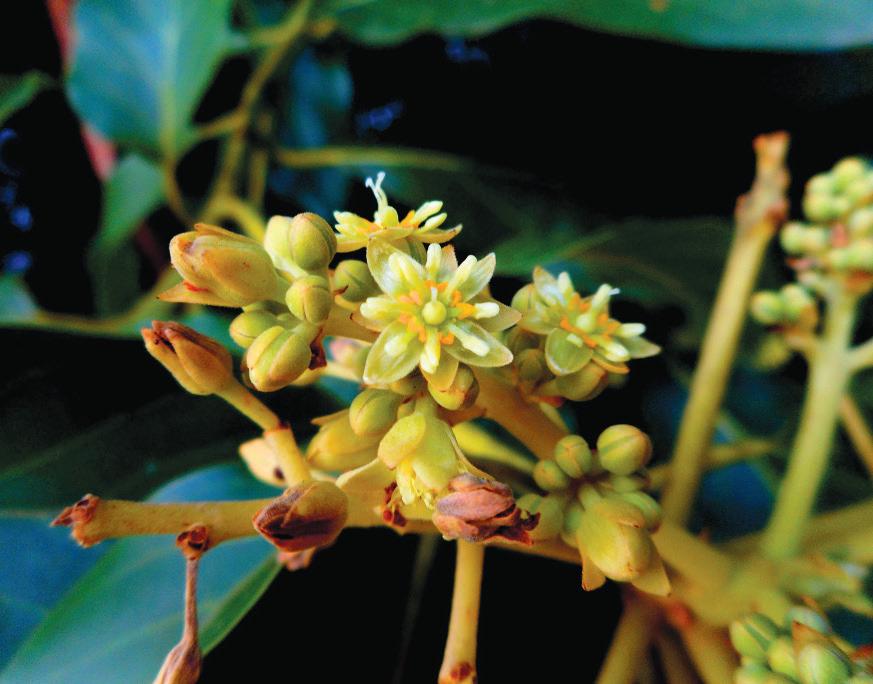







22 SPRING 2024 FROM the Hive
1 2 3 4 5 6 8 7 9





1 ORANGE BLOSSOM
Generally produced in late fall in the heady flowering orange groves, this honey is very regional.
Color: Light to medium amber
Flavor: Aroma is distinctively citrus, sweet honey with orange blossom flavor and hints of rose
Best for: Sweetening teas, baking, dressings and daily use
2 EUCALYPTUS
Though eucalyptus is not native to California, this honey has become as common as the trees in our region. But be sure to find it from backyard or small producing beekeepers, or it will likely be imported from Australia.
Color: Light to medium amber
Flavor: A cool menthol flavor with an herbal malty aftertaste
Best for: Sweetening teas
Specific health benefits: Said to helpful in reducing cold symptoms and headache pain
3 AVOCADO
The bees that produce this honey are often housed in hives within avocado orchards and collect pollen from the avocado blossoms.
Color: Dark amber
Flavor: Rich and buttery, strong.
Best for: Salad dressings, cocktails, and sauces
4 BUCKWHEAT
Only available from specific local beekeepers with fields of buckwheat nearby, this honey is said to have extremely high levels of antioxidants present.
Color: Dark amber
Flavor: Strong, malty with molasses overtones and a lingering aftertaste
Specific health benefits: Said to be good for wound recovery, helpful in reducing cold and flu symptoms, especially coughs
5 LAVENDER
Found locally from beekeepers who keep hives in lavender fields, this honey is surprisingly flavorful, even if one doesn’t like lavender.
Color: Light to medium amber
Flavor: Medium sweetness, hints of camphor and sweet tobacco
Best for: Served with baked brie and sweetening lemonade
6 ALMOND
Like avocado honey, this comes from hives set in almond orchards during the blooming season season, but is not as common due to its bitter flavor.
Color: Dark amber
Flavor: Strong, nutty with a slight bitterness
Best for: Savory dishes, ravioli fillings, meat sauces
7 CLOVER
This honey comes from the nectar of white blossoms on the clover plant. It is what people often consider “regular honey” because it is the most common honey in the world. According to local beekeeper Wendi Mitchell, most commercial clover honey will be imported from the Dakotas or Northern California.
Color: White to light amber
Flavor: Mild with slightly tangy aftertaste
Best for: Baking and everyday use.
8 SAGE
One of the most common flavors for bees set in the L.A. and Ventura County hills, this honey is distinct and strong.
Color: White or water white
Flavor: Pungent, herbal with a floral aftertaste
Best for: Charcuterie boards, or served with cheese.
9 WILDFLOWER
Most common after a wet spring, wildflower honey could be made from any flowers, so the flavor will vary widely depending on region.
Color: Light to medium amber
Flavor: Tends to have floral notes, a lighter flavor
Best for: Everyday use, cocktails, making jun or kombucha
SPRING 2024 23 EdibleSanFernandoValley.com
A FULL PLATE
Chef feeds others with his many food-related activities
WORDS AND PHOTO BY BRENDA REES
I’m enjoying a quesadilla at Lenchita’s, a long-standing restaurant located at a busy intersection in Pacoima, as I chat with Chef Art Luna. A guitarist serenades diners. The parking lot is full with a lunchtime crowd and the servers are dashing by with plates of traditional Mexican food.
Luna is the grandson of Angelita “Angie” Renteria, who started the business in 1977 and still comes daily into the restaurant where the menu offerings haven’t changed and are still in demand.
“There used to be only four tables [at the original location a few blocks away],” says Luna, who helps run the restaurant, among numerous other endeavors. “If you were hungry, you had to sit down and eat with complete strangers. But by the end of the meal, you would know them.”
Food as a pathway to bring people together has been an ongoing thread in Luna’s career. His relationship with the culinary arts began as a young kid watching his grandmother make tortillas, slapping and forming the masa in her hands.
“She gave me one with a little bit of salt and squeezed it for me,” he recalls. “It was warm and amazing. That’s how today I treat my food and cooking. We are going to use the freshest ingredients, and we are going to make something together to build a moment in life.”
MANY CULINARY HATS
A man of many hats, Luna has taught culinary classes for more than 20 years at Los Angeles Mission College, a community college in Sylmar. Plus, he’s the chef/owner of Lenchita’s Commercial Kitchen, where individuals and business owners can cook, bake and create meals while taking advantage of Luna’s expertise. Open since last summer, this venture fills a need in the area and keeps Luna connected to the community. The kitchen also takes advantage of a warehouse space that had been empty for years.
Chef Art Luna uses plenty of cornmeal for Lenchita’s delicious housemade tortillas.

Taking more than two years to build out, its five commercial kitchens contain everything a chef could want. “Other commercial kitchens have only hoods and sinks,” says Luna, who later walks me through the space, pointing out ovens, stoves, fryers, grills and more. Two kitchens are buzzing with caterers packing up meals and cleaning.
Networking is key to making the kitchens successful, says Luna, who enjoys the thrill of training and working with those who have a passion for the food industry. “I have learned so much from start-ups, like what to do and what not to do!” he says with a laugh.
He recalls his early days as a student when the most important thing he needed to learn was timing. “Finding a rhythm and being prepared while feeling that pressure to be fast and efficient—that’s a big lesson for anyone in the business.”
Luna hopes to bring his students from Mission College to the kitchens to practice and showcase their skills in an unfamiliar location. Luna teaches four days a week at the college where he learned the art of cooking. He especially credits his mentor Chef Rudy Garcia, who encouraged him to keep moving forward.
CHEF Spotlight
24 SPRING 2024 Edible San Fernando Valley
“Today, I can still hear his voice, telling me to remember this, remember that, ‘Don’t send anything out before you taste it,’” says Luna, who went on to graduate from Johnson & Wales University with a bachelor’s degree in hospitality and restaurant management. He also has an MBA from Woodbury University.
Luna says the community college students still come to the program “a little green,” and who may only know about the glamor of cooking from television cooking shows.
“They need to know about the hard work, the hours upon hours,” he stresses. “When they start in any kitchen, they will be washing dishes and prepping, but if they work hard, they’ll get promoted,” he says. To broaden their horizons, Luna recommends his students study under four different chefs.
For 10 years, Luna also participated in a program teaching youth at juvenile detention camps. He tells of bringing in a fresh head
Lenchita’s 13612 Van Nuys Blvd., Pacoima
@lenchitas_restaurant
Lenchitas.weeblyte.com
of broccoli one day and seeing the students’ mystified expressions. “‘Broccoli comes frozen in a box,’ they said. I told them, ‘It’s time to open your minds.’”
Luna remembers how exploring the cuisines of other cultures opened his world. After receiving his certificate at Mission College, he studied in Miami where he learned about new foods and cuisines. At Johnson & Wales, he learned Texas-style barbecue and Southern soul food. Today, Italian and Thai are among his favorites.
A career in food means Luna is always learning, tasting and sharing. Over the years, he’s seen attitudes shift about food, which makes him hopeful for the future. “People realize that if you eat better, you live better,” he says. “And that means inside and out.”
Brenda Rees is a writer living in Eagle Rock. Originally from Minnesota, she fondly remembers how Campbell’s Cream of Mushroom soup was a kitchen staple.
Lenchita’s Commercial Kitchen
13612 Van Nuys Blvd., Pacoima
213-505-2789
@lenchitasCK


SPRING 2024 25 EdibleSanFernandoValley.com
taste California’s best fine wines and craft brews, and shop at the artisan vendors, gourmet food trucks or silent auction on the shores of beautiful Lake Casitas. Admission includes a fine crystal wine glass, unlimited tastes of wine and beer, live music by Area 51, and a lakeside dance floor! OjaiWineFestival.com
Come
GOING DUTCH
A Brief Exploration of Amsterdam
BY TAMI CHU
Just after magazine deliveries of our winter issue and a couple weeks before Christmas, I packed up and flew with three of my adult children (ages 18, 18 and 20) to Amsterdam in the Netherlands. We had seven days to see it all and two of those days were just traveling to and fro.
We arrived at Amsterdam Airport Schiphol early in the morning, long before we could check into our hotel. While I had read that many hotels there would hold your luggage for you, we opted instead to keep our backpacks while we visited the home of my 18-year-old son’s friend Lars, who lives 30 minutes away in the small town of Heiloo. (For reference, Heiloo is almost exactly the population of the city of Calabasas, while Amsterdam’s population is just over half the population of the entire San Fernando Valley.)
While we could have easily traveled by train, Lars met us at the airport and drove while we gaped at the Dutch countryside and peppered him with questions about the region and its rich history. It was drizzling on and off, a state that continued for most of our time there, with temperatures that stayed in the 40s and 50s.
In Holland, drivers have to pass rigorous licensing tests that put ours to shame, and with good reason. With the excellent public transportation and bicycles as the main modes of transit, cars (many of which are much smaller than what you might find on California roads) have lower priority in the grand scheme of mobility, especially within city limits.

We went to winter markets, visited the Zaanse Schans historic district to see the windmills and wooden clogs, checked out recommended attractions, walked along centuriesold canals, gawked at the Dutch Gothic-style city buildings and ate as much food as we could.
EDIBLE Exploration
26 SPRING 2024 Edible San Fernando Valley

I felt so honored to be able to see how the locals lived as it really enhanced our understanding of the Netherlands and its people. English is the most common second or third language in the area, so while we attempted to learn a bit of Dutch—pronouncing words so badly at times that Lars couldn’t contain his laughter—communication was not at all a problem anywhere we went. In fact, one of the locals told us that there are 135 ethnicities and several languages represented in the population of Amsterdam.
Once we arrived in Heiloo, Lars took us to the neighborhood grocery store to pick up a few things—a five-minute walk away—then he and his dad, who is vegetarian, set us up with lunch in their comfortable home. The food included my son’s favorite Dutch treat, commonly consumed for breakfast: toast with haglslag and pindakaas (thick chocolate sprinkles and peanut butter). There was also fresh grapes, apples and avocados, bread with local Gouda cheese and a pesto spread.
Did you know that Gouda (pronounced GHOW-duh in Dutch with the beginning sound similar to the ch in challah), originally comes from the town of Gouda in the Netherlands? Yes, we brought cheese home. No, there isn’t any left.
Drinks were a local sweet juice that was meant to be cut with sparkling water and water from the tap—the Dutch are very proud that their water is considered some of the cleanest in Europe, checked daily in a lab and with an average pH of 8.06.
After lunch, we hitched another ride with Lars back to the city so our touristy time could begin, leaving my son to stay local with his buddy’s family for the night.
We stayed at the Citiez Hotel Amsterdam West. It’s about 6 km or 20 minutes from the city center via tram, which we could grab 100
In the historic district of Zaanse Schans just 20 minutes outside of Amsterdam, visitors can watch and be entertained by a clog maker who shows the old and new process of making the wooden shoes. A short walk up the road, you can taste and learn about the history of Gouda cheese making.

steps from the hotel entrance. There are plenty of hotels closer to Central Station, some surrounded by cheese shops and quaint alleyways and open city squares. As an international hot spot, Amsterdam’s hotel options, from location to level of luxury, are nearly endless.
Over the next five days, we went to winter markets, visited the Zaanse Schans historic district to see the windmills and wooden clogs, checked out recommended attractions (“This is Holland” was completely worth it and free with our city card pass), walked along centuries-old canals, gawked at the Dutch gothic-style city buildings and ate as much food as we could.
Was there more we wanted to see? So much. Would we go back? In a heartbeat. In fact, I would really like to see the country in a different season, to experience the tulips in bloom and some of the museums that were closed while we were there.
SPRING 2024 27 EdibleSanFernandoValley.com
1. Food trucks are not foreign to Amsterdam. In fact, in May, the city celebrates the rolling kitchens with a festival.
2. The aptly named Centraal Station is not just central to the city center and the heart of the historic district, but also a major port of public transportation including everything from trains and buses to ferries and tourist boats.
3. A sustainable farm style house in Heiloo, just 30 minutes from Amsterdam. A neighbor tells us that the thatched roof only needs upkeep about every few years, but it should last 30–50 years.
4. Dating back to the 1600s, the 100km (around 60 miles) of iconic canals in Amsterdam were originally built for water management and defense and are now still valuable transportation pathways.
5. Bikes are everywhere in Amsterdam with designated bike roads that often take right of way over cars and pedestrians. This is a typical alleyway in the historic area.
6. The House of Bols is a fun tourist experience to learn about the Genever spirits made from a 400-year-old recipe and experience the sights and smells of its creation.
7. The 5D experience called “This is Holland” was recommended by a local and is well worth the time. While you are waiting for your entry time, stop by The Coffee Lab, an espresso bar inside the neighboring school with beans roasted sweet, sour or bitter.




1 2 4 6



TIPS TO MAKE YOUR AMSTERDAM TRIP AMAZING
• First step: If you don’t already have a passport, allow for about six months to obtain it, just in case anything goes wrong. A passport also works in lieu of a RealID, in case you haven’t upgraded yet. There is not really a downside to having a passport in hand, especially if there is any travel in your future.
• Prepping ahead: Make sure to bring plenty of cash (euros) since some places in Amsterdam do not accept credit cards. Our first night, we just needed to grab some fresh fruit and vegetables to assist in combating the jet lag and found that the supermarkets don’t take cards. Cash it is.
• Helpful hint here: Most banks will do a currency exchange at the current exchange rate without extra cost or fees for their own customers. Make sure to plan ahead though; most banks don’t have euros on hand and it can take up to two weeks after you order.
• Be ready to walk a lot. Starting off in the massive airport (seriously, with the amount of shops and eateries inside, you could spend an entire day meandering and never see the same place twice), we easily got our 10K steps on the first day, just strolling around the block.
• To really get a tourist experience try either the Go City Pass or the I Amsterdam City Card available for purchase online ahead of time or once you have arrived. This allows access to most of the city’s museums and discounts on some fun attractions such as canal and river cruises, “This is Holland” 5D experience, Old Holland tours, food tours, Bols cocktail tour, bike rentals and more.
• As I mentioned, Amsterdam has excellent public transportation which consists of trains, trams, buses and ferries. The I Amsterdam City Card includes access to most of the city’s public transportation. To travel in and out of the city, especially to visit more of the nearby towns and attractions, the Amsterdam & Region Travel Ticket is the better purchase. For more information on both options, scan the code below.
WHEN TO TRAVEL TO AMSTERDAM
March is the beginning of the tulips. Traditionally, when we think of Holland, the windmills, wooden clogs and tulips are the first images that rise. Late March to early May are a great time to see the tulips in nearby Keukenhof—home of 7 million flowering bulbs—as well as to visit some of the more serious and reflective destinations like the National Holocaust Museum, which opens in March.
July is beach weather in the Netherlands and while there is no shortage of beaches, there is also no shortage of tourists on those beaches. Summer is always a high season for travel so there may be a bit more traffic at some of the more attractive attractions.
December is a time of winter markets and Christmas lights, so if that is your thing, it is the perfect holiday trip. The weather, for the most part, is cold and a bit rainy, but won’t prevent visits to Old Holland, canal cruises and loads of museums. November and December are also popular times to visit Amsterdam, so plan ahead to get the best out of your time there. See our list for some of the best winter markets in the city.
For food- or garden-related events to check out and dates to be aware of in 2024, scan the code:


3 5 7
REDUCING JET LAG
Jet lag is a real thing and can really get in the way of enjoying your destination, especially if your trip is only a few days long. Amsterdam is nine hours “ahead” of California (PST). When arriving in the Netherlands, the body’s circadian rhythm is still adapted to the previous time zone, so 8am in Amsterdam will still feel like 11pm in your body. Symptoms of jet lag can include insomnia, daytime sleepiness, appetite and digestive dysregulation, low mood, loss of concentration and lowered alertness.
Here are some science-based tips for speeding up jet lag recovery: The body responds to zeitgebers, external cues that affect the regulation of circadian rhythm—cues like light, exercise and food. Applying these zeitgebers at the right time (based on research) can drastically reduce the symptoms of jet lag.
• Sleep: Start ahead of time! If possible, start going to bed an hour earlier each day for at least three days. Also wake up an hour earlier and expose yourself to bright light (if it is still dark outside, a light box might be a great investment).
• Light: Upon arrival, be sure to get out in the sun, especially the first morning in the new time zone.
• Exercise: Keep an exercise routine even after travel, especially in the morning of the new time zone.
• Hydration: Travel is a notorious dehydrator. Staying hydrated before, during and after significant travel can help the body adapt to the new time zone. As challenging as it might be, try to avoid caffeine and alcohol during travel. These can make the physical symptoms of jet lag worse.
• Meals: Whenever possible, switch mealtimes to the new time zone. If you are hungry but it isn’t mealtime, try a small snack or large glass of water. This can also be started ahead of time when possible. Additionally, increase pre- and probiotic foods to help with potential digestive issues.
TRAVELING THE WORLD SUSTAINABLY
While in Amsterdam, I had an enlightening conversation with a local geology teacher who had decided that he had done more than enough air travel in his life and to do more would be irresponsible from a carbon footprint perspective. He and his wife still traveled around Europe, but it was by bicycle for the most part. His only regret in his choice seemed to be that he would not be able to see the Grand Canyon in person.
Tips to keep your travel more sustainable:
Buy a reusable bottle at the airport, or bring an empty water bottle, and refill it often on your trip.
Pack lighter. We bought travel backpacks and packed strategically so that we only had a carry-on each.
Fly economy whenever possible. The less room you take on a plane, the smaller the carbon footprint.
Use public transportation locally whenever possible.
Eat locally. Local food made by local vendors has a smaller carbon cost.
Stay in eco-friendly hotels. Amsterdam is very eco-conscious, so while there may be a “Best of” list out there, many of the hotels have energy savings and low-waste procedures already in place.
Do only one long flight or international trip per year and keep your home life as waste free as possible as a balance.
Use the Curb6 carbon footprint calculator to determine the carbon cost of your trip: Curb6.com.
Offset your travel by supporting projects that reduce emissions: SustainableTravel.org.
The iconic narrow canal houses in Amsterdam date back to the 17th century when an influx of wealthy traders outweighed the city’s housing supply. The buildings were often used as both home and work, with residences on the upper floors. The roof hooks used to lift supplies and goods are still present today.


30 SPRING 2024
EDIBLE for Kids
A-MAZING BEES!
ART BY RAMIAH CHU
Can you help the bee find its way through the honeycomb maze to get to the honey?
Then you can help them by coloring these hardworking bees and their beautiful hive.
Did You Know?

A beehive usually holds around 10–12 combs. Bees use honey as food for the larvae (or babies). During the winter, a hive can hold up to 90 pounds of honey!


greatest sculptors. Beeswax is made from glands on their abdomen. They form the beeswax into shapes called cells using their mouths. The cells are the structure of the honeycomb and are where the baby bees and the food is stored. There are about 10,000 cells in each comb.
Beekeepers provide bees with special homes so they can produce even more honey. Then they can harvest the extra honey to eat or sell.
SPRING 2024 31 EdibleSanFernandoValley.com
LESSONS FROM A SMORGASBORD
Tastes of many things add up to a delicious life
BY CHRISTINA BERKE | ILLUSTRATION BY RAMIAH CHU
“YOU HUNGRY?”
My paternal grandmother must have asked that question a thousand times in my little life. My answer was always yes. It was easy to say yes, not just because she offered everything under the sun to her grandchildren but because she did so with warmth and without judgment. With her, I never had to choose just one thing.
I spent a long time feeling untethered to both of my cultural identities: my Chilean mother, my Jewish father. And because technically Jewish heritage is passed on only from the mother’s side, I wasn’t sure where that put me. I didn’t have a bat mitzvah or quinceañera (which is mostly a Mexican tradition), never went to temple, and I wasn’t raised speaking Spanish. But what I did have was food.
One of the ways my grandmother showed her love was through her cooking. Though the circumstances of her youth are lost to lore, I knew she’d left, or fled, Turkey; that she grew up without much, including consistent meals; and she wound up in New York at some point. There’s a story that she was an orphan and lived in foster care until she met my grandfather. After they married, they moved out west to California, and the kitchen became a place where she wanted her family to gather.
As in most immigrant families, cooking became a way to honor

heritage and find comfort while navigating grocery stores and new foods. My grandmother made it her mission to ensure her grandchildren were well-fed, loved and always had a seat at the table. Though my parents divorced when I was young, she never let that impact how she treated my mother or her grandchildren.
On the weekends I was with my father, we drove out to the San Fernando Valley to spend time swimming and eating and visiting with my grandparents. The first one to greet us was always
32 SPRING 2024
FIRST Person
Though we didn’t celebrate religious holidays, every meal still had a feeling of celebration. Here we were gathered, here we were happy.
my grandmother, arms eager to hug, a glowing smile lighting up her entire face, eyes shining like the sun catching glitter on my sneakers. She was a classic grandma in that she spoiled us with hugs, kisses and plenty of home-cooked meals.
“You hungry?” she asked us before the car door even closed. “Come, come, lunch is ready.”
Anytime we walked into our grandparents’ cul-de-sac home, the smells reached our noses first. Sweet and savory with the buzz of the television in the background let us know it was time to relax.
“What do you want?” she said, fridge door open and waiting. But there was already a spread on the table and kitchen countertops.
The smorgasbord of food was ample and diverse. Mac ’n’ cheese for my sister, roast beef for my father, egg salad, matzo ball soup, ambrosia, eggs, halva, dried apricots, tomatoes, jams, puddings. Though we didn’t celebrate religious holidays, every meal still had a feeling of celebration. Here we were gathered, here we were happy.
But it wasn’t always a piece of cake. My grandmother cooked through the grief of my father’s brain cancer. She cooked through the return of her own breast cancer. In the ’90s, we didn’t have dialogue around trauma, but looking back now I suspect there was a calm and control through sautéing and mixing that she lacked in the waiting rooms as the mother of a son who was dying. The kitchen had a meditative quality and it took her mind off reality for a while. She even had the cooking channel on during her own hospital stays, where she was enchanted by midnight reruns of Emeril Lagassé. “It’s twoa-clock in the morning,” she’d say in her particular accent. “And he’s there with the g*d damn BAM!” She smiled whenever she imitated Emeril’s high-energy catchphrase.
But it was more than food. The diversity of my grandmother’s kitchen table showed that there was space for it all. She introduced small pieces of her own heritage in ways that felt accessible, digestible and ready for us to learn about.
I wish I had been old enough to ask, curious enough to say something beyond, “That’s yummy!” Often it was us sitting down to eat as she fluttered around us light and happy as a butterfly, whistling,
singing, and asking how our week was. We then rushed back to go play, leaving her to clean up the mess.
Back then I didn’t have an interest in cooking, but I was a good eater. It was rare I turned up my nose at a food and I think this is partly because of my grandmother’s varied way of feeding us. A little of this, a scoop of that.
This last holiday season, I found myself mixing and matching while putting together a charcuterie board. There was room for everything—the nuts, the dried and fresh fruit, the pickles, the hummus, the gluten-free breads alongside the sourdough slices, various cheese and meats, empanadas, menemen. It showed up as this playful, choose-your-own-adventure love note that reflected our cultures, one that encouraged guests to eat, drink and be merry. That whatever was on their plate was OK.
While food might be trivial for some—or about survival, necessity and routine for others—for my grandmother it was an invitation. By allowing room for different types of food, especially from places I’d yet to experience first-hand, it expanded my sense of what was possible. As an adult it made it easy to say yes to trying Ethiopian injera and miser wat, or fermented stingray with a cup of makgeolli and even marmite on toast.
Many chefs do this now with fusion foods, taking aspects of their culture, identity and parts of their story to show there are more ways than the traditions we’ve grown accustomed to.
My grandmother passed away just when I was starting to take an interest in cooking, and I don’t have the chance to preserve that piece of my history. But I can honor her with her attitude towards food and life and through repre senting various cultures with their dishes, making room for it all.


Christina Berke is a writer and educator from the Conejo Valley. She’s currently working on a novel. Visit ChristinaBerke.com to learn more.

THE SPRING TABLE
a gathering of local artisans and goods
Hosted by Sunrose California Eatery
6 3 4 5 2
1
2 1 1 1

Nestled on the edge of Agoura Hills’ Whizin Market Square, Sunrose California Eatery beckons with its community-oriented ethos and vibrant ambiance. This stylish daytime haven seamlessly blends classic Californian flavors with a contemporary modern flair, offering delectable farm-fresh cuisine. From its airy setting to its commitment to crafting nearly everything in-house, Sunrose embodies an authenticity-driven approach to dining. Partnering with like-minded suppliers, they ensure each dish meets their high standards of quality. Whether you seek a weekend escape or a weekday respite, Sunrose warmly invites you to savor unforgettable moments of laughter and joy. Welcome to a place where every meal feels like coming home.
5046 Cornell Rd., Agoura Hills TheSunroseCA.com, @thesunroseca
1. Vintage Tall Faux Bamboo Brass Candlesticks, England, Artisan-Crafted Niko Wine Glassware and Ceramic Cylinder Vase with Gunmetal Glaze all available at Maude Woods Artful Living | 55 E. Holly St., Pasadena | 626.577.3400 | MaudeWoods.com
2. 2022 Far Niente Chardonnay, Napa Valley and 2018 Beringer Private Reserve Cabernet both available at Agoura Beer & Wine Co. | 28851 Agoura Rd., Agoura Hills | 818.337.8832 | AgouraWine.com
3. Seasonal Fruit and Vegetable Share Family Size Farm Box delivered to home or community drop provided weekly by Good Box Organics | 818.614.8131 | GoodBoxOrganics.com
4. Wild Strawberry and Lavender Organic Lemonades made with local fruit by Lori’s Original Lemonade | Made in Ventura, available in most stores | LorisOriginalLemonade.com
5. Custom Bella Board with mixed hard and soft cheeses, artisan charcuterie, nuts, olives, seasonal fruit and berries made by CharcuterieLA | 14545 Ventura Blvd., Sherman Oaks | CharcuterieLA.com
6. Artisan Organic Three-Day Fermented Sourdough Boule and Batard on a Custom Sapele and Maple Wood Guitar shaped Cutting Board by Random Acts of Breadness | 2214 W. Magnolia Blvd., Burbank | 818.562.7303 | Breadness.com
Flowers provided by Farmivore in Camarillo.
Sponsored Content
Photo by Stephanie Helguera
BE GRACEFULLY FED Soup for the body and soul
WORDS BY CHELSEE LOWE
When Traci Weintraub was diagnosed with an autoimmune disorder she was unwilling to alter her diet, despite her physicians’ suggestions. French fries, chicken tenders and mac ’n’ cheese were among her preferred snacks, she recalls. She worked a fast-paced job in television, and cooking elaborate, healthful meals was the least of her concerns.
That was, until she collapsed on her kitchen floor one day.
Weintraub’s mom flew to her side. Determined to come up with a game plan, they set their sights on soup. Easy to cook (and freeze) in large quantities, soup also allowed her to cut common allergens like dairy and gluten from her diet to see how her body felt. Another benefit? Soups meant she didn’t have to sacrifice flavor.
Chicken sausage and white bean soup (organic, gluten-free and dairy-free) was among the first recipes Weintraub loved, but she cooked, jarred and shared additional soups, too. When friends and acquaintances started asking to purchase her wares, a new door opened.
While still working in television— and handling her symptoms from what was eventually diagnosed
as Lyme disease—Weintraub started making and selling her soups out of a shared commercial kitchen. In November 2019, she opened Gracefully Fed, a kitchen and café on Ventura Boulevard in Sherman Oaks. (The name is a nod to her childhood nickname, Grace, given to her by her brother.)
Weintraub and her team cooked and shipped soups nationwide through the pandemic. Today, customers come in for gluten-free sandwiches, salads, smoothies, gluten-free baked goods and, of course, soups.
And there are so many to choose from. On a blackboard posted in the café, customers will find 35 soup options, with top sellers being the original chicken sausage and white bean, matzo ball, cauliflower turmeric and chicken tortilla.
There’s even a detox soup (and cold remedy), featuring a spicy broth made with
lemongrass, serrano chiles, ginger, turmeric, diced tomatoes and spinach. And while the shop isn’t vegan, there are plenty of vegan options, including a broccoli “cheddar” soup that gets its cheesy flavor from nutritional yeast.
Two things make Gracefully Fed special in Weintraub’s mind: One, her food is delicious and satisfying and it’s organic, gluten-free and dairy-free.
“I’m a foodie and an eater,” Weintraub says. “I wanted to create a space where you can eat food that reminds you of what you used to eat; I haven’t been allergic my whole life, and I remember how great a peanut butter and jelly sandwich tastes—I want that.”
The second? Her food has become a beacon for the autoimmune community and beyond.
“People come into the shop and share that they have lupus, Hashimoto’s or something else and they just want to talk,” Weintraub says. “And I welcome it. It’s hard when you’re first thrown into this world. Now we have a huge community of autoimmune people, and they feel like they have a place to go. I love that so much.”
Gracefully Fed
13944 Ventura Blvd., Sherman Oaks GracefullyFed.com
Chelsee Lowe is a San Fernando Valley–based contributor who specializes in writing about food, travel, parenting, culture and design. When she needs a break, she goes on solo outings around the Valley for lattes or burritos.


EDIBLE Notable
Photos courtesy of Gracefully Fed

AVGOLEMONO SOUP
Greek Lemon Chicken Soup
Editor’s Note: This springtime recipe yields enough for eight generous servings, making it ideal for when you have guests over for dinner. You can also freeze the extra soup for an easy meal later.
This recipe is courtesy of Traci Weintraub, owner of Gracefully Fed. She uses cooked chicken breast for this recipe, but says you can also use rotisserie chicken.
Makes approximately 8 servings
2 quarts (8 cups) chicken stock, divided use
½ teaspoon salt
¼ teaspoon pepper
1 pound cooked chicken, shredded
2 cups cooked long-grain brown rice, divided use
2 large egg yolks
¼ cup lemon juice
½ bunch chopped fresh dill, approximately ⅓ cup
In a saucepan, bring 6 cups chicken stock to a simmer over mediumhigh heat. Add salt, pepper, chicken and 1½ cups rice.
In a blender, add remaining ½ cup rice, egg yolks, lemon juice and the 2 cups reserved chicken stock; purée
Add purée to saucepan and stir. Cook soup at a gentle simmer for 30 to 40 minutes. Stir in fresh dill before serving.
SPRING 2024 37

TUESDAY
1 Glendale Gateway Certified Farmers’ Market
Tuesday 10am–2pm
801 N. Brand Blvd., Glendale SupportingArms.org/events.html
2 Hidden Hills Farmers’ Market (Exclusive Community Market)
Tuesday 2–6pm @ccfminc
3 Sherman Oaks Farmers’ Market
Tuesday 2–6pm
14006 Riverside Dr., Sherman Oaks RawInspiration.org
4 CSUN Farmers’ Market
Tuesday 10am–2pm
18111 Nordhoff, Northridge RawInspiration.org
5 Pasadena Certified Farmers’ Market
Tuesday 8am–noon
Villa Parke Center, 363 E. Villa St., Pasadena PasadenaFarmersMarket.org
WEDNESDAY
6 Canyon Country Farmers’ Market
Wednesday 4–8pm
18410 Sierra Hwy., Santa Clarita CanyonCountryFarmersMarket.com
7 Heart of the Canyons Farmers’ Market
Wednesdays 4–6pm
9666 Foothill Blvd., Sunland @hotcfarmersmarket
8 The Oaks Farmers’ Market (Exclusive Community Market)
Wednesday 2–7pm
25464 Prado De Las Flores, Calabasas @ccfminc
9 Northridge Farmers’ Market and Family Festival
Wednesday 5–9pm
Northridge Fashion Center Mall
9301 Tampa Ave., Northridge
Northridge-Farmers-Market-and-Family-Festival.business.site
10 Panorama City Kaiser Farmers’ Market
Wednesday 9am–1:30pm
Kaiser Medical Center, 13652 Cantara St., Panorama City 310-383-3708
11 Warner Center Farmers’ Market
Wednesday 10am–2pm
5820 Canoga Ave., Woodland Hills



FRIDAY

18





















19 2 25 28 11 22 9 17 3 16 34 26 6 38 39 40
10 13 31 8 4 37 18 33
Illustrations by Ramiah Chu
South Pasadena Farmers’ Market Thursday 4–8pm 920 Meridian Ave., South Pasadena SouthPasadenaFarmersMarket.org
Woodland Hills Kaiser Farmers’ Market Thursday 9am–2pm
Kaiser Medical Center 5601 De Soto Ave., Woodland Hills 310-383-3708
THURSDAY 12
13
In
14 Altadena Neighborhood Farmers Market Friday 4–8pm 578 W. Palm St., Altadena @ccfminc 15 Monrovia Street Fair & Farmers’ Market Friday 5–9pm 700 S. Myrtle Ave., Monrovia MonroviaStreetFairMarket.com 16 Olive View Medical Center Certified Farmers’ Market Friday 9am–2pm 14445 Olive View Dr., Sylmar SupportingArms.org/events.html 17 Reseda Farmers’ Market Friday 4–8pm
Reseda Blvd., Reseda @ccfminc
8500
Topanga
9am–1pm
N.
Farmers’ Market Fridays
1440
Topanga Canyon Blvd., Topanga TopangaFarmersMarket.com
FOR SAN FERNANDO VALLEY, SANTA CLARITA AND PASADENA
SATURDAY
19 Agoura Hills Farmers’ Market at Whizin Market Square
Saturday 10am–3pm
28914 Roadside Dr., Agoura Hills RawInspiration.org
20 Burbank Farmers’ Market
Saturday 8am–noon
101 N. Glenoaks Blvd., Burbank BurbankFarmersMarket.org
21 El Nido Farmers Market
Saturday 1am–2pm
Pacoima Family Source Center
11243 Glenoaks Blvd., Pacoima mkaplan@elnidofamilycenters.org
22 Main Street Canoga Park Farmers’ Market
Saturday 9am–1:30pm
7248 Owensmouth Ave., Canoga Park CoastalPacificMarkets.com
23 La Cañada Flintridge Farmers’ Market
Saturday 9am–1pm
1346 Foothill Blvd., La Cañada Flintridge RawInspiration.org


24 NoHo Farmers’ Market
Saturday 9:30am–2:30pm
5000 Colfax, North Hollywood FarmersMarketNorthHollywood.com
25 Old Town Calabasas Farmers’ Market
Saturday 8am–1pm
23504 Calabasas Rd., Calabasas CCFM.com
26 Old Town Newhall Farmers’ Market
Saturday 8:30am–1pm
24500 Main St., Santa Clarita NewhallFarmersMarket.com
27 Pasadena Victory Park Farmers’ Market
Saturday 8am–12:30pm
2925 E. Sierra Madre Blvd., Pasadena PasadenaFarmersMarket.org
28 Woodland Hills Farmers’ Market
Saturday 8am–1pm
5650 Shoup Ave., Woodland Hills 818-300-3023
SUNDAY
29 Atwater Village Farmers’ Market
Saturday 9am–2pm
3528 Larga Ave., Atwater Village SeeLA.org/markets-atwater-village
30 Glendale Artsakh Farmers’ Market
Glendale Central Library Park
Sunday 10am–3pm
222 E. Harvard St., Glendale @glendaleartsakhfarmersmarket
31 Encino Farmers’ Market
Sunday 8am–1pm
17400 Victory Blvd., Van Nuys Sepulveda Basin OneGeneration.org/farmers-market
32 Montrose Farmers’ Market
Sunday 8am–1pm
2300-2314 Honolulu Ave., Glendale ShopMontrose.com/harvest-market-andmarketplace
33 Porter Ranch Farmers’ Market
Sundays 9am–2pm
In the Kaiser Permanente Lot 20000 Rinaldi St., Porter Ranch @ccfminc
This list was updated March 2024 but as details do change, please contact the markets for the latest information.
If you know of another farmers’ market that is not listed, please let us know at info@ediblesfvalley.com.













34 Santa Clarita Certified Farmers’ Market
Sunday 8am–noon
College of the Canyons Parking Lot 5
Valencia Blvd. & Rockwell Canyon Rd.
Santa Clarita Vccfm.org
35 Studio City Farmers’ Market
Sunday 8am–1pm
Ventura Pl., Studio City
StudioCityFarmersMarket.com
36 Toluca Lake Farmers’ Market
Sunday 9:30am–2:30pm
Wells Fargo Lot
10225 Riverside Dr., North Hollywood
TolucaLakeFarmersMarket.org
37 Westlake Village Farmers’ Market
Sunday 10am–2pm
2797 Agoura Rd., Westlake Village Rawinspiration.org
CSAs, Farm Stands & Special Markets
38 Forneris Farms
15200 Rinaldi St., Mission Hills FornerisFarms.com
39 Sanchez Produce
16230 Sierra Hwy., Santa Clarita @Sanchezproduce Cash only
40 Tapia Bros. Farm Stand
5251 Havenhurst Ave., Encino @tapiabrosfarm
South Central Farmers CSA
Various pickup and delivery options
SCFCoop.SouthCentralFarmers.com
Good Box Organics
Various pickup and delivery options
GoodBoxOrganics.com
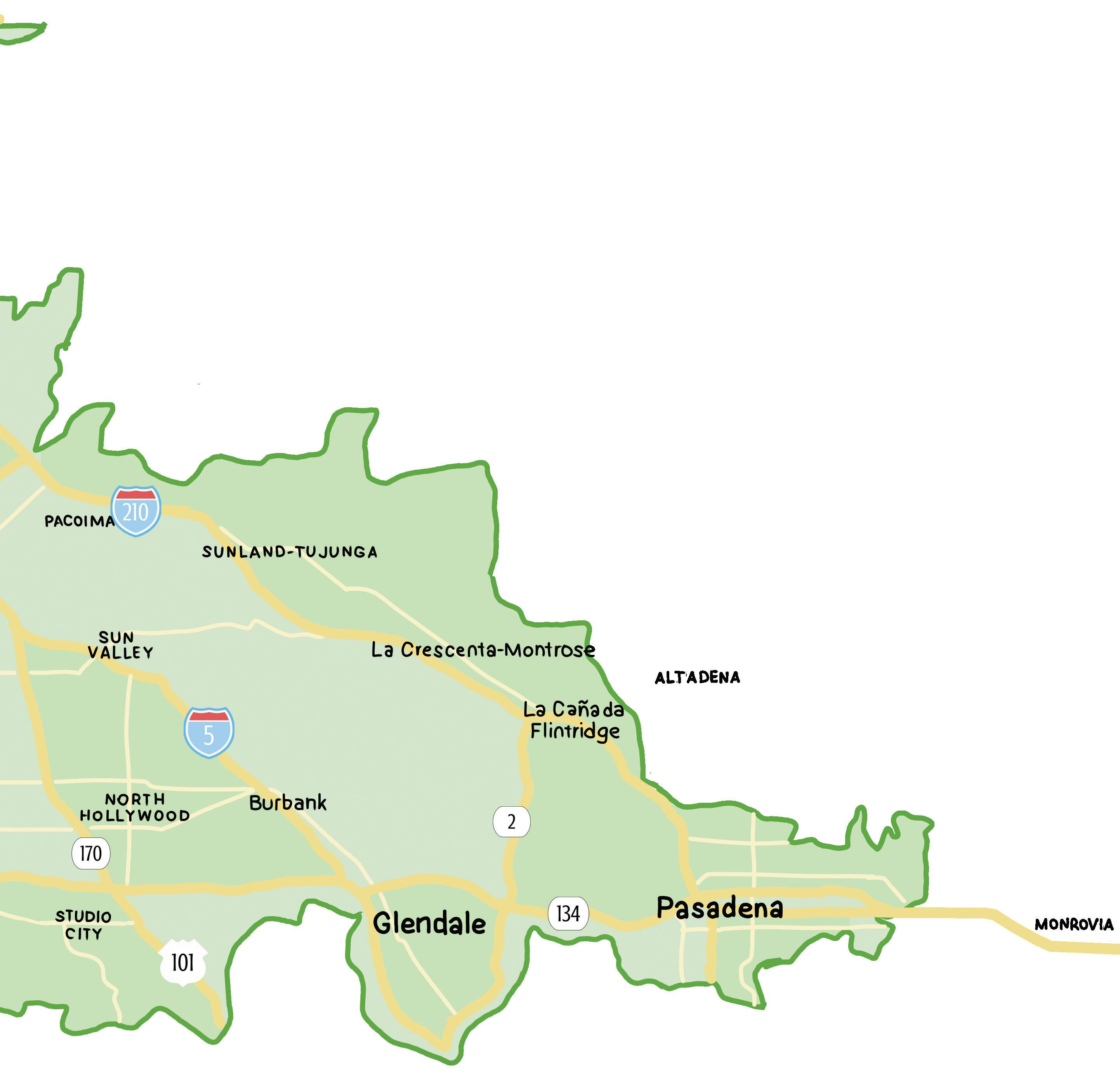

35 24 36 20 1 29 32 23 14 12 27 15 5
7 30
21
SPRING VEGGIE FRITTATA
Recipe by Samantha Sirota, founder of Good Box Organics— connecting farmers and families since 2010.
This easy dish is perfect for incorporating any veggies you find at the farmers’ market (or in your fridge)! For over a decade this frittata has been my go-to for weekly meal prep—simply cut the frittata into squares, refrigerate and then reheat them in the toaster oven for a nourishing breakfast. It’s also a perfect dish to serve at a brunch. You can swap out the veggies and herbs for whatever your family likes and is in season: zucchini, asparagus, spinach, mushrooms, etc. For the frittata shown here, I added cubes of bread to the top of the veggies before pouring in the eggs to upgrade the brunch factor. Enjoy!
Serves 4–6
Butter
1 bunch kale, chopped
½ cup chopped broccoli
Optional: 1 green garlic/leek, sliced, and/ or any other vegetables desired
½ cup shredded cheese
13 eggs, whisked together
2 tablespoons chopped fresh thyme or dill
2 teaspoons salt
½ teaspoon black pepper
1 dash garlic powder

Preheat oven to 350°F and use butter to grease a casserole dish or pie tin. De-stem kale and chop into fine ribbons less than ¼ inch wide. Chop broccoli or other veggies into small pieces.
Fill casserole dish with veggies and sprinkle cheese on top.
In a large bowl, whisk together the eggs, herbs, salt, pepper and garlic powder. Pour your whisked eggs on top, moving the bowl as you pour to try to cover evenly. The eggs should cover all the goodies; if not, add more whisked eggs.
Cook for approximately 35 minutes, or until golden brown and puffed up. This might take 5–15 minutes longer, depending on the size of your dish and moisture content of the veggies; just make sure the eggs have set, especially in the center.
Serve warm.
LAST Bite
40 SPRING 2024 Edible San Fernando Valley
$32,500
TOTAL IN CASH PRIZES AWARDED TO MARKETS

2,435 MARKETS PARTICIPATED IN 2023
VOTE FOR YOUR FAVORITE MARKET




























































 Sarene Wallace Managing Editor
Sarene Wallace Managing Editor








































































































































